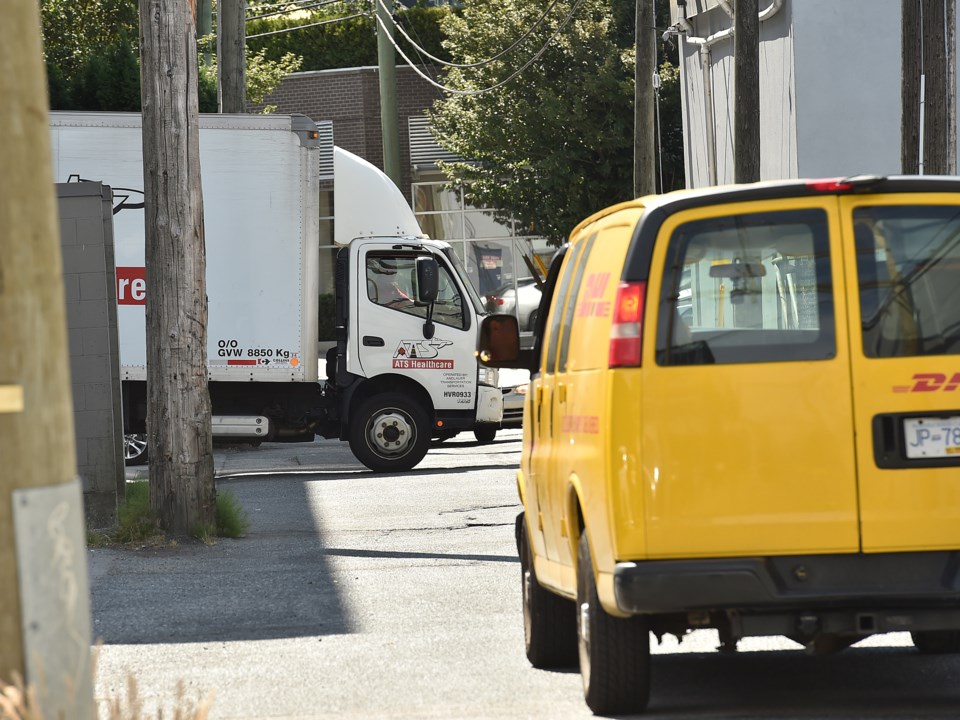Imagine a Vancouver that loses 30,000 jobs in light industry businesses — such as those in the transportation and distribution sectors — over the next five years to neighbouring municipalities.
Imagine some leaving the region altogether
For now, it’s only a threat.
But it is one the Vancouver Economic Commission is worried will escalate as it works to keep the city as the most thriving economy in Canada, despite Vancouver’s well-known affordability pressures.
Catherine Warren, the commission’s CEO, didn’t mince words or numbers when she spoke to city council Tuesday about the uncertain future for businesses in Vancouver’s light-industry zones.
“One of the most significant threats to our local economy is the erosion of light industry,” Warren said.
“Up to 50 per cent of industrial businesses could be displaced from the city in the next five years, taking with them 30,000 jobs, $3.6 billion in annual revenues and $1.2 billion in annual wages.”
Why?
Pietra Basilij, the commission’s manager of industrial initiatives, who also spoke to council, first pointed to the spike in industrial land values over the past five years as a factor.
During that period, Basilij said, the price of industrial land increased 30 to 100 per cent in some districts.
“And around that time, we started hearing from businesses a real concern about their lease rates going up, their property taxes and their inability to stay in the city,” she said.
“We’re really worried about that now because most of these businesses are on leases. About 70 per cent of businesses are leasing their space. They’re not owner-operators and the majority of those are on triple-net leases.”
A triple-net lease is an agreement a business owner signs with a landlord where said owner has to pay all real estate taxes, building insurance and maintenance.
“So as those leases come to the end of their term — many of them are three-, five- or 10-year leases — those businesses are being displaced from the city as their lease rates go up,” she said.
Last year, the commission surveyed businesses that have “an industrial element to their operation” and found that 10 per cent would need to relocate in the next two years.
“And another 40 per cent said it was likely,” Basilij said. “So that’s where the 50 per cent comes from.”
These conclusions are further explained in the commission’s survey, which said businesses most likely to leave are in the transportation and distribution sectors.
“Displacing industrial businesses not only significantly impacts Vancouver’s employment base, it also impacts the cost of goods and services in the city,” the survey said.
Survey respondents reported more than 50 per cent of their clients are located within the city limits and 35 per cent of their suppliers.
Moving out of town would mean potentially losing business connections, or increasing costs of their services to reach their clients and suppliers.
It would also have an environmental impact and worsen traffic congestion in the region, the survey said.
“Emissions from transportation in Vancouver’s manufacturing, wholesale-distribution sectors accounted for 54,400 tonnes of carbon emissions in 2015,” the survey said.
Despite Vancouver’s industrial past, more than half of Vancouver’s industrial businesses are less than 20 years old. And the same percentage has only been in their current spaces for less than six years.
To keep those businesses in Vancouver, the commission is working directly with the city to develop programs and policies to prevent further erosion of industrial businesses.
Last year, the commission launched the “industrial concierge service” to activate underutilized industrial space to help save money, share resources and increase opportunities for collaboration with other businesses.
The commission is focused on identifying spaces in the False Creek Flats, the Downtown Eastside and other areas of the city zoned for industry to help landowners, businesses and city staff work together to retrofit, permit and fund affordable space projects.
The commission receives the majority of its $4.4 million in funding from the city. Unlike other economic development agencies in Canada, the commission does not receive any money from the provincial or federal government for its core funding. But the commission does receive some funding for programs.
In 2016, Toronto Global received $3.8 million from senior levels of government. Montreal International received $3.6 million and Quebec International, $2.6 million.
Prior to the commission’s turn at the lectern in the council chamber, Gil Kelley, the city’s director of planning, provided an overview of the city’s economy.
In his presentation, he used a graph that showed where the job growth has occurred — and decreased — in Vancouver between 2006 and 2016.
The biggest drops were in manufacturing and the wholesale trade. The biggest gain was in professional, scientific and technical services.
@Howellings



